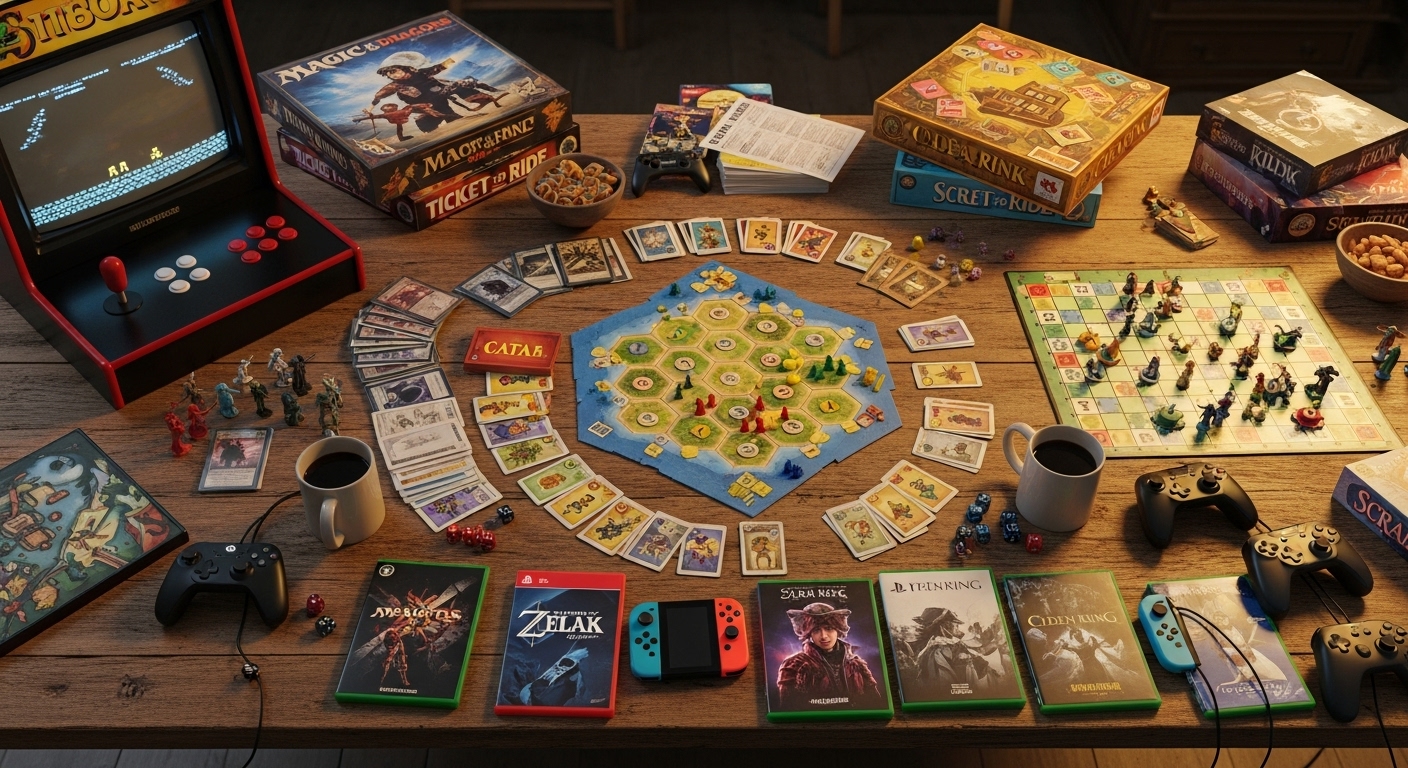Gaming, once viewed as a pastime for the youth, has rapidly evolved into a multi-billion-dollar industry that spans across generations, cultures, and countries. From humble beginnings as simple arcade games to the visually stunning, immersive experiences of today, video games have undergone tremendous advancements. Not only have they changed in terms of graphics and technology, but they’ve also had a profound impact on society, culture, and even the economy. In this blog post, we’ll take a deep dive into the history, growth, and influence of gaming, exploring how it has shaped the world we live in today.
The Beginnings of Gaming
The Birth of Video Games: Arcade and Console Era
Video games as we know them began in the late 1950s and early 1960s with early experiments in computer graphics. However, it wasn’t until the 1970s that gaming became a commercialized industry. The launch of Pong in 1972 marked the first major success for the gaming industry. Developed by Atari, Pong was a simple two-player tennis simulation that became a global phenomenon. This early success of arcade games sparked the rise of dedicated arcades, where people would gather to play games on machines that often cost a quarter per play.
The 1980s saw the golden age of arcade games with titles like Space Invaders, Pac-Man, and Donkey Kong. These games not only defined the era but also laid the foundation for gaming’s broader cultural significance. The arcade boom was accompanied by the rise of home consoles. In 1985, Nintendo released the Nintendo Entertainment System (NES), which became a huge success and helped to establish home gaming as a legitimate and desirable activity. Other companies, like Sega and Atari, followed suit with their own consoles, competing for market dominance.
The Console Wars and the Growth of Home Gaming
The 1990s marked the beginning of a fierce competition between gaming giants like Sony, Microsoft, Sega, and Nintendo. This era is often referred to as the “Console Wars,” where each company vied for dominance in the home gaming market. Sony’s PlayStation made its debut in 1994, and with its focus on 3D graphics, it changed the gaming landscape forever. The success of PlayStation, along with titles like Final Fantasy VII, Gran Turismo, and Tekken, cemented Sony’s place as a major player in the industry.
In contrast, Nintendo remained committed to its traditional 2D platformers and family-friendly titles like Super Mario and The Legend of Zelda, appealing to a broader audience. Sega’s Dreamcast, though not as commercially successful as its competitors, introduced innovative features like online multiplayer gaming, which foreshadowed future trends in the gaming world. The Nintendo 64, released in 1996, introduced groundbreaking 3D technology with titles like Super Mario 64 and The Legend of Zelda: Ocarina of Time, which are still hailed as some of the greatest games of all time.
By the end of the 1990s and the early 2000s, gaming was becoming a mainstream activity, appealing to more than just kids and teenagers. Adult players started to emerge, and the industry began to evolve to meet this broader demographic. Gaming companies, aware of this shift, started to focus on creating experiences that could appeal to a more diverse audience, resulting in the rise of new genres, including role-playing games (RPGs), first-person shooters (FPS), and sports simulations.
The Rise of Online Gaming and MMORPGs
The Internet Age and the Emergence of Multiplayer Games
The late 1990s and early 2000s were pivotal for online gaming. As home internet connections improved, gaming began to evolve beyond solo or local multiplayer experiences to include massive, interconnected online worlds. EverQuest, released in 1999, was one of the first MMORPGs (Massively Multiplayer Online Role-Playing Games), allowing thousands of players to interact in a single virtual world. This was revolutionary, as it introduced the concept of persistent, evolving online worlds that players could explore together.
Following in its footsteps, World of Warcraft (WoW), released in 2004, became a cultural phenomenon, attracting millions of players from all over the world. WoW offered a rich, immersive fantasy world, a compelling story, and an engaging social experience, which kept players coming back for years. MMORPGs like WoW, Guild Wars, and Final Fantasy XIV are not just games—they’re virtual societies where players create avatars, form guilds, build friendships, and embark on epic adventures together.
Meanwhile, the rise of online shooters like Counter-Strike and Halo marked the shift from single-player games to competitive, team-based experiences. These games emphasized skill, strategy, and coordination, leading to the rise of esports as a legitimate form of entertainment. Competitive gaming and tournaments began to garner attention from sponsors, and games like League of Legends, Dota 2, and Fortnite would eventually elevate esports to the global stage.
The Social Aspect of Online Gaming
Online gaming has created a new form of social interaction. What started as a way to play with friends has grown into a global community, where players from different parts of the world come together to collaborate, compete, and socialize. This is especially evident in games like Fortnite, where players communicate and interact through voice chat and in-game events. The ability to connect with friends and strangers alike has made gaming a social experience, creating a sense of belonging for many players.
Social media platforms like Twitch and YouTube have become integral parts of the gaming ecosystem. Streamers and content creators have turned gaming into a form of entertainment that extends far beyond the act of playing the game itself. These platforms allow viewers to interact with their favorite gamers, watch tournaments, and stay updated on the latest gaming trends. In fact, the rise of gaming content creators has transformed many streamers into household names, with some gaining millions of followers and turning their passion for gaming into full-time careers.
The Technological Revolution: Graphics, AI, and VR
Advancements in Graphics and Realism
One of the most striking changes in gaming over the past two decades has been the improvement in graphics and realism. Early games like Pong and Space Invaders were simple in design, with basic pixelated graphics. However, as technology advanced, games started to feature more detailed environments, lifelike characters, and complex animations.
In the 2000s, games like Halo 3, The Elder Scrolls V: Skyrim, and Uncharted pushed the boundaries of what was possible with console hardware, offering photorealistic visuals that made players feel as though they were part of the game world. The release of Grand Theft Auto V in 2013 took this a step further, with a living, breathing open world that included intricate details like realistic weather systems, day-night cycles, and an expansive map that mimicked real-world geography.
The arrival of ray tracing technology in the late 2010s brought another leap in graphical realism. Ray tracing allows for more realistic lighting, shadows, and reflections, making the virtual world look more like the real one. With the next generation of consoles like the PlayStation 5 and Xbox Series X, and powerful gaming PCs, these visual upgrades are now a standard feature in many modern games, making virtual worlds more immersive than ever.
The Emergence of Artificial Intelligence
Artificial Intelligence (AI) has played a crucial role in enhancing gaming experiences. NPCs (Non-Playable Characters) that once followed rigid, pre-programmed paths can now adapt to player behavior, offering more dynamic and realistic interactions. Games like The Last of Us Part II feature AI that reacts to the player’s actions in more complex ways, creating an unpredictable and engaging experience.
Moreover, AI is being used to create procedurally generated content. In games like No Man’s Sky, AI algorithms generate vast, procedurally generated universes, offering players endless exploration possibilities. The use of AI in gaming has the potential to revolutionize the industry further, from creating more intelligent adversaries to generating expansive, dynamic game worlds that evolve in real-time.
Virtual Reality and Augmented Reality
The 2010s introduced a new frontier in gaming: Virtual Reality (VR) and Augmented Reality (AR). VR gaming immerses players in 3D worlds through headsets like the Oculus Rift, PlayStation VR, and HTC Vive. Games like Beat Saber, Half-Life: Alyx, and Resident Evil 7 have demonstrated the power of VR to offer more interactive, physically engaging experiences. VR is not just limited to gaming but is also being explored in areas like education, healthcare, and even remote work.
On the other hand, AR games like Pokémon Go have brought the digital world into our everyday environments. By using a smartphone’s camera and GPS, players can see virtual objects overlaid onto the real world, creating a unique blend of gaming and real-world interaction. AR technology is still in its infancy but holds vast potential to change the way we experience games in the future.
The Cultural Impact of Gaming
Gaming as a Form of Entertainment and Art
Over the past few decades, gaming has evolved from a niche hobby to a mainstream form of entertainment. It is now considered on par with film and television in terms of cultural significance. Major game franchises like The Legend of Zelda, Final Fantasy, The Elder Scrolls, and Halo have become iconic, with deep lore, engaging characters, and emotional stories that rival the best in cinema.




